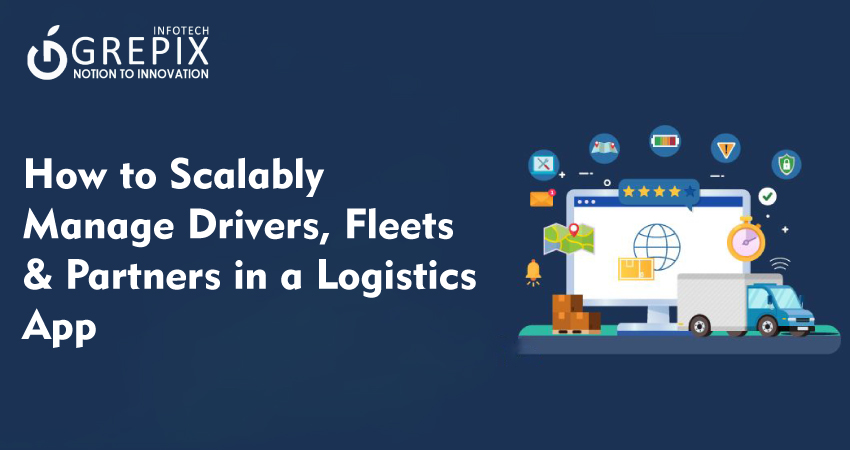How to Scalably Manage Drivers, Fleets & Partners in a Logistics App
Scalability is the defining competitive advantage for logistics businesses in a data-driven, on-demand economy. As delivery volumes surge and new geographies open, a fleet management logistics app becomes indispensable serving as a digital hub for real-time tracking, driver management software, and seamless partner integration logistics. This guide unpacks how businesses can use scalable logistics platforms to unlock efficiency, safety, and growth.
Managing drivers, fleets, and partners scalably is the cornerstone of modern logistics success. This guide explores how a fleet management logistics app integrating robust driver management software and scalable logistics platform capabilities drives operational excellence. Discover how real-time tracking, automation, and partner integration logistics tools foster resilience and agility in unpredictable markets. Case studies demonstrate productivity boosts of up to 28% and faster delivery times, while actionable strategies help companies navigate complex supply chains, regulatory challenges, and data management. Learn proven approaches to technology adoption, asset tracking, and stakeholder visibility that empower logistics businesses to efficiently scale operations as demand grows. Whether launching a startup or optimizing a legacy fleet, this comprehensive article delivers proven solutions for scalable driver, fleet, and partner management culminating in a powerful call to action to embrace digital transformation and share industry insights.
Why Scalability Matters in Logistics
Modern supply chains are volatile: labor shortages, disruption risks, and unpredictable demand require scalable processes and technology. Companies that rely on manual management or rigid legacy systems often fall behind, struggling with delayed deliveries and rising costs. Scalable fleet management logistics apps solve these problems by automating scheduling, compliance, asset tracking, and communication.
Benefits of Scalable Logistics Platforms:
- Support seamless expansion into new markets, handling more vehicles and drivers efficiently.
- Enable quick onboarding of partners and carriers via partner integration logistics solutions.
- Automate compliance and safety workflows to meet regulatory demands as fleets grow.
- Reduce operational bottlenecks and errors with advanced analytics.
Case Study:
CleverDev Software’s custom fleet management solution delivered a 28% increase in productivity for a major US logistics firm by automating workflows and optimizing asset management.
Fleet Management Tools: The Digital Backbone
Fleet Management Logistics App Features
The best fleet management logistics app supports:
- Real-time GPS tracking and route optimization.
- Automated asset and vehicle utilization analytics.
- Integrated compliance and document management.
- Scalable architecture to handle fluctuating load and rapid fleet expansion.
- ERP integration for unified business processes.
Real-World Solutions
Fleetio Case Studies:
Organizations from government fleets to contractors saw improved vehicle downtime tracking and ROI analysis after adopting fleet management software transforming decision-making and reducing costs through automation.
Gtropy Case Study:
A supply chain giant switched to a new GPS-enabled fleet management platform, boosting asset utilization, enabling trip-based KPI monitoring, and improving financial accuracy through dedicated dashboards and ERP integrations.
Key Features for Scalability:
- Microservices Architecture: Allows horizontal scaling by adding servers as fleet size increases, ensuring uninterrupted performance.
- Cloud-Native Infrastructure: Supports real-time analytics, remote access, and distributed team management.
- Custom Dashboards: Give management macro and micro views of vehicle activities and costs.
- Automated Reporting: Ensures compliance and tracks operational efficiency as business grows.
Partner Integration Logistics: Unifying the Ecosystem
Why Integration Is Critical
Seamlessly connecting third-party carriers, insurance, maintenance, and analytics partners is vital for scalable logistics platforms. Partner integration logistics tools ensure data flows smoothly between businesses, avoiding delays.
Real-Life Example:
Laverne Group integrated with eight different carriers via Omniful, reducing Riyadh delivery times from 4–6 days to under 3 hours and slashing fulfillment costs through smart automation and real-time data integrations.
Best Practices for Partner Integration:
- Leverage deep API-level integrations across sales, warehouse, and carrier systems.
- Use real-time rate fetching and carrier comparison tools to optimize cost and performance.
- Monitor carrier KPIs and adjust dynamically to maintain service quality.
- Maintain a diversified carrier portfolio based on geography and performance.
Success Strategies
- Multi-Carrier Automation: Automatically assigns shipments to the best-performing partner using real-time data, ensuring fast, accurate deliveries.
- Integrated Data Portals: Provide customer and partner access for transparent communication and order tracking.
- Dynamic Routing: Uses AI and analytics to optimize last-mile delivery paths for speed and cost efficiency.
Driver Management: The Human Element
Driver Management Software Essentials
Scalable driver management software is key for monitoring, motivating, and protecting drivers while keeping operations efficient.
Core Features:
- Digital scheduling and shift management.
- Automated safety and compliance monitoring.
- Real-time task assignment and completion tracking.
- Mobile apps for drivers with instant messaging, incident reporting, and route updates.
Case Study:
Through a tailored management platform, one logistics firm increased productivity by streamlining compliance workflows and driver inspections, reducing incident rates and automating critical document management.
Building a Driver-Centric Culture
Organizations like Walmart highlight the value of driver satisfaction initiatives offering incentives, transparent communication channels, and ongoing training to retain talent and minimize turnover.
Actionable Tactics:
- Use gamification and performance dashboards to boost motivation.
- Implement instant support channels for issue resolution.
- Roll out incident tracking and geofencing for driver safety.
Scalability in Driver Management
Leveraging a scalable logistics platform, managers can:
- Quickly onboard seasonal or temporary drivers.
- Reassign tasks dynamically during high demand.
- Automate compliance checks for large teams to minimize legal risks.
Fleet & Driver Management: Technology Integration
Smart Integration With Existing Systems
Customizable fleet management logistics apps maximize ROI by leveraging IoT, cloud computing, and seamless integration with pre existing processes and hardware.
Integration Features Include:
- IoT-enabled asset tracking for real-time visibility.
- Cloud-based mobile apps for remote operation and monitoring.
- Advanced analytics for predictive maintenance and performance optimization.
Example Implementation
A window manufacturer improved inventory turnover ratio by 150% through a logistics app with upgraded data visibility, automated asset management, and cloud integration.
Conclusion
Scalable management of drivers, fleets, and partners is the foundation of long-term logistics success. Fleet management logistics apps, driver management software, scalable logistics platforms, and robust partner integration logistics tools empower companies to maximize asset utilization, enhance driver productivity, reduce operational costs, and meet ever-changing customer demands. By leveraging automation, analytics, cloud infrastructure, and seamless integration, businesses can scale without sacrificing quality or efficiency. To stay ahead, logistics leaders must embrace technology, foster a culture of transparency and safety, and continuously optimize workflows
FAQs
1. What is a fleet management logistics app?
A fleet management logistics app is a centralized platform that automates asset tracking, driver scheduling, compliance, and analytics for scalable, data driven logistics operations.
2. How does driver management software improve safety and compliance?
Driver management software automates task assignment, incident reporting, and compliance workflows, reducing manual errors and keeping fleets legally protected.
3. What are the benefits of scalable logistics platforms for growing businesses?
Scalable logistics platforms support seamless expansion, quick partner onboarding, and process automation saving time and costs as business grows.
4. How can partner integration logistics tools reduce delivery times?
By connecting with multiple carriers and comparing rates and performance in real time, partner integration logistics tools optimize carrier selection and speed up deliveries.
5. What analytics features should I look for in a fleet management logistics app?
Look for advanced asset utilization analytics, cost tracking, predictive maintenance, and real-time monitoring to boost ROI and operational transparency.







